The epidermophythosis of the feet is a fungal disease, caused by the pathogens of the dermatophytes who have settled on the skin of a person, by the Tricophon genre.
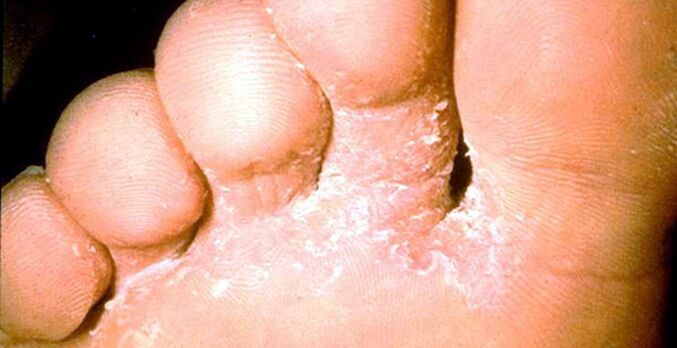
There is a complex infection of nails and skin in the feet and between the fingers that are interconnected.
The diseases of some professions that are in heat and high humidity, in favor of the development of mushrooms are particularly sensitive to diseases: they are athletes, miners or people simply do not follow their feet hygiene.
The reasons for the apparition
The main condition for the appearance of the disease is the infection of the skin of the legs, that is, the entry of fungal disputes.This happens in public places or in direct contact with the courier through personal hygiene products, for example shoes or socks.
The main places of accumulations of various mushrooms are public showers, bathrooms, saunas, changing rooms and so on.
In addition, favorable conditions for the development of the mushroom should be created, which is facilitated by the following factors:
- increase in humidity;
- Sweat the legs;
- in the long term wearing uncomfortable shoes;
- Low quality socks or shoes with insufficient ventilation;
- Professional activities (sports, work), when the legs are in constant warmth and experience waterlogging;
- thrombosis vein;
- Blood vessel diseases;
- diabetes mellitus;
- weakened immunity;
- overload;
- Stress and nervous overvoltage.
The mushroom is not always activated when setting up, since the body has its protective functions.The disease occurs only in the presence of pathologies.
For example, the socks squeezes the blood vessels and the level of the blood flow is reduced or the legs are constantly hot with high humidity and the acidity of the skin decreases, creating favorable conditions.
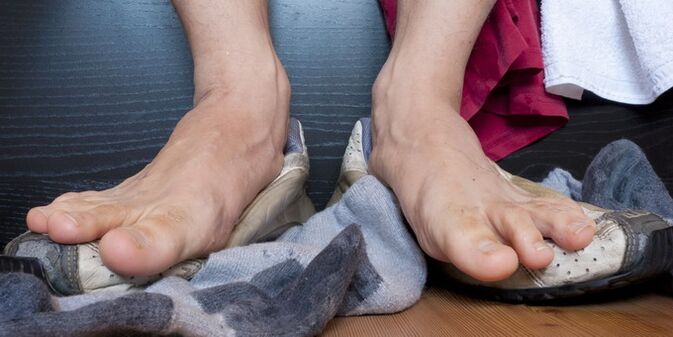
This is also facilitated by stress and overload that reduce body protection against any pathogens.
Symptoms and phases of the mushroom
The disease is characterized by forms and stadiums of the epidermophythosis.The main symptoms characteristic of all forms are the peeling and redness of the skin between the fingers of the feet and on the feet.There are four phases of the disease:
Stadium deleted or mild
Among the fingers of the feet, there are outbreaks of skin peeling, the feet are clean.The patient practically does not experience discomfort or other unpleasant symptoms.
Squamous-hyperkatotic stadium
At this stage, the disease manifests itself more clearly.On the phalanges of the fingers and between them, as well as on the sides of the feet, there are seals of the skin of a brown or bluish tint.
The skin is detaching with dry stairs.The patient has an increase in the dryness of the legs.The forms of white and yellow can appear similar to seeds.
The infected places exacerbated itch.An unpleasant smell comes from the legs.
Intriginal stage
The legs are constantly wet and fascinating.Among the fingers of the feet there are similarities of Edema.The swelling of the white or yellow skin appears.
The skin is detaching itself on the entire surface of the feet and fingers of the feet.There may be sores, cracks and erosion, which sometimes bleed, if damaged.
The patient experiences constant discomfort, itching or weak pain, especially when walking.The detachment of the skin is significant and seals.
Dyshidrotic stadium
On the entire surface of the feet and between the fingers of the feet, formations that remember the bubbles appear.They accumulate a liquid that exudes damage to the walls of the bubble.
Subsequently, swelling and inflammation of the skin may occur.The feet and fingers continue constantly and the legs acquire a strong smell of mold that cannot be suppressed of soap or other means.
Complications
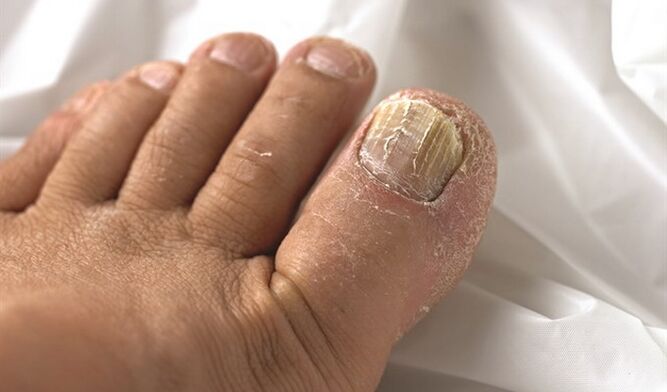
In addition, the disease falls on the nails that gradually become yellow, therefore they deform and exfolian.This happens in every third case of epidermophitics, if tightened with the treatment.
In the most advanced cases, the mushroom "throws" in other parts of the body, causing the appearance of stains on the skin, an allergic reaction or other pathologies.
Treatment
To treat the disease, you have to contact a mycologist.Various tests and studies will be conducted on the basis of which adequate treatment will be prescribed.
Therapy aims to destroy the mushroom.For this, the funds are used both for internal use and for the room, moreover, at the same time.
Medicines
The mushroom treatment occurs at home and lasts, depending on the stadium, from 2-3 months to 1 year.To suppress the activity of the mushroom from the inside, use the 2-Clorin-4-Nitrofenol drug.
At the same time, the affected areas should be treated with local drugs (creams, gel, ointments):
- Clotrimazole.
- Tolnaftat.
- Mikonazole.
- Terbinafina.
- Econazole nitrate.
- Nafthyfin hydrochloride and others.
When purulent secretions and inflammation appear, itraconazole is usually prescribed.A systematic approach allows you to manage the infection more effectively.
The choice of drugs and the course of treatment is carried out by the attending physician based on the clinical picture.
Popular remedies
The means of traditional medicine are used as a further measure of the fight against the mushroom, but not independent.
Popular recipes can only help in the initial stages of the disease.Consider some of them:
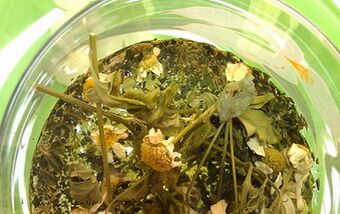
- Vaseline and salicylic acid.For 1 teaspoon of oil gelatin, half of the aspirin or salicylic acid tablet is taken, mixed and applied to the area between the fingers of the feet, slightly rubbing.This will help stop the spread of the mushroom and relieve unpleasant symptoms.
- A decoction of herbs.The following herbs that have an antifungal and anti -inflammatory effect should be taken: Chamomile leaves, Equieto, St. John must and eucalyptus leaves.All herbs are taken in equal quantities (1 teaspoon for 0.5 l of water).The water is brought to a boil and boiled for 10 minutes, after which it also insisted for 30 minutes.In the decoction, the legs are loose, gradually adding hot water.
- Bold oil for thirst.A cotton swab is moistened in oil, which stinks the affected areas.This is a good antiseptic that relieves pain, itching and inflammation.
- Soda, salt and soap.In a hot water basin, a piece of soap for laundry and 1 tablespoon of soda and salt are dissolved.The leg setting procedure is performed every day, preferably before bedtime.This will help clean the skin from the keratinized parts and will better influence the effectiveness of the drugs that penetrate deeper into the fabrics of the fingers and feet.
- Boric acid.For the treatment, a solution (2%) of boric acid is used, which stinks the legs with a cotton swab.This is a strong antiseptic for mushrooms.However, you should be careful and do not perform the procedure too often to not get a chemical burn.
Shoes and underwear
In addition to direct treatment, it is still necessary to monitor the conditions of shoes and linen.This is important, since therapy can be insignificant if it is neglected by hygiene.

The shoes must be constantly dried and the socks can be changed every day.It is useful to treat daily shoes with formaline for disinfection.
After conducting water procedures, the legs are deleted thoroughly with a clean dry towel, in particular between the fingers of the feet.Then apply medicinal creams or ointments prescribed by the doctor immediately.
With an increase in the sweating of the legs, a decoction or infusion of oak bark, as well as normal vinegar, helps.
The main thing is to keep your legs always dry, since humidity is a favorable environment for the development of the mushroom.
Prevention
There are different preventive measures aimed at preventing the impact or infection with a mushroom on the legs:
- Wash the legs several times a day, dry them dry;
- You cannot use the socks, shoes or towels of other people;
- Daily shoes must always be dried before they are used;
- In public places, use slippers or other shoes, then use disinfectants to reduce the risk of infection;
- The shoes should be comfortable and not cause legs of the legs;
- regularly visit a doctor for preventive exams for any disease;
- Eat correctly;
- Reduce the use of alcohol and sweet food.
Conclusion
Epidermophytosis is a very unpleasant disease, as it ruins the appearance of the legs and causes a strong unpleasant smell.
The legs are constantly submitting and really start stinking.This interferes with normal life and leads a person.
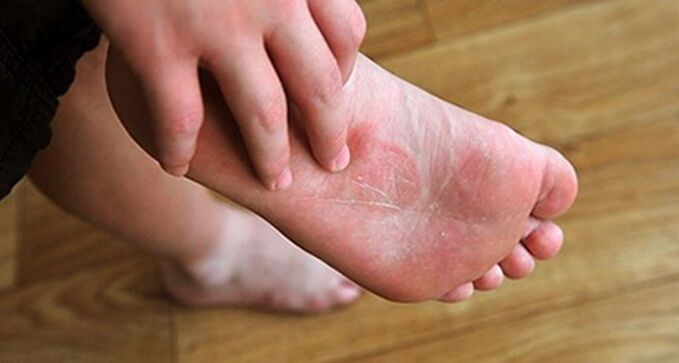
First of all, the disease affects personal life and, therefore, the treatment should start the first symptoms, given the risk of infection with the mushroom of others.
In the initial phase, the disease is easily therapy and recovery occurs after a couple of months.However, in an advanced state, this can take a year or more, so it is not necessary to delay.


















